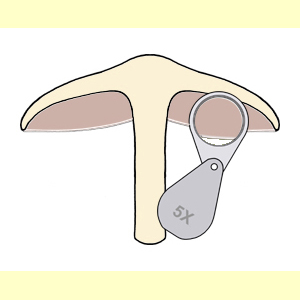
Observe the colour of the lamellae edge by turning over the fruit-body and looking at the lamellae side-on at an angle. Use a x5 hand lens to look carefully at the lamellae edges.
Lamellae edge colour is best observed in young fruit-bodies, because the edge may erode with age and the colour contrast may then be less obvious, especially where the edges are pale or white against a darker lamellae face. Paler or darker edges usually indicate the presence of microscopic cheilocystidia (sterile elements on the lamellae edge).
Choose this state if: the edge of each lamella is paler than the face. The edge appears as a white or pale line. A paler lamellae edge is also often serrate or fimbriate (and then called albofimbriate).
